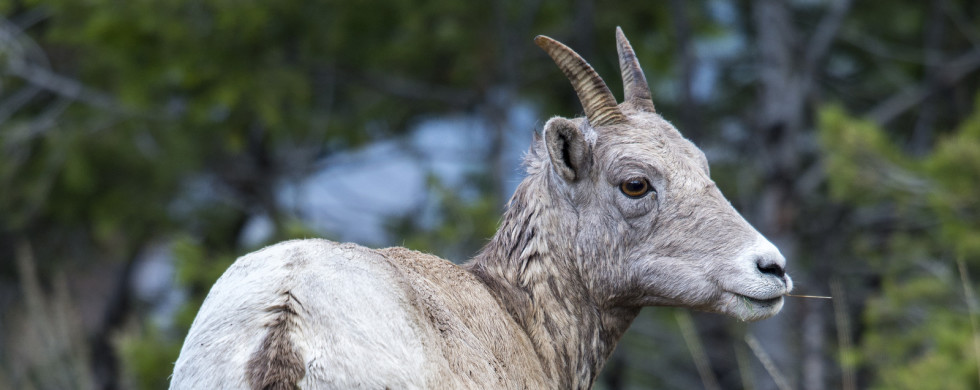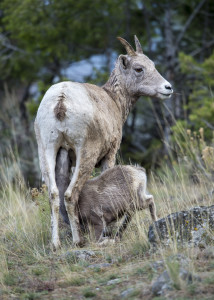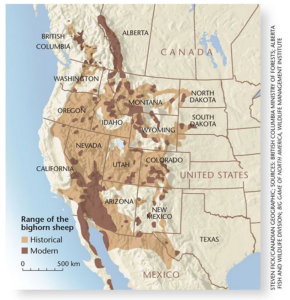
31
2016Cliffhanger
Shot of the Month – January 2016
 If you just look quickly at this shot you might think, “Huh, nice goat thing” and move along. But if you look a bit closer you will see that we have a lovely mountain maternal moment going on here. See the dining lamb? Lower…..bingo, there you go.
If you just look quickly at this shot you might think, “Huh, nice goat thing” and move along. But if you look a bit closer you will see that we have a lovely mountain maternal moment going on here. See the dining lamb? Lower…..bingo, there you go.
As it turns out, the goat is actually a sheep, a Bighorn sheep to be exact. I photographed this one in Yellowstone NP. The name is a bit of a misnomer for the ewe as you can see that her horns are not all that big. As it often goes with species naming, the glory goes to the Y chromosome holder. The Bighorn males get all of the attention due to their massive horns and tendency to want to smash them into another ram to prove who’s the biggest and baddest ram in town. The last sheep standing gets the right to date all the cute ewes in the hood. It’s a dramatic show to be sure, but that is a story for another day.
Bighorn sheep can be found in the mountainous regions of North America from southern Canada to Mexico. At the beginning of the 18th century, there were about 1.5 to 2 million bighorn sheep in North America. Then humans did what they do and by 1920 the sheep had been wiped out in Washington, Oregon, Texas, North Dakota, South Dakota, Nebraska, and part of Mexico. So, in about 120 years the number of Bighorn Sheep dropped from a couple of million to a few thousand. There are about 70,000 sheep left on the continent now and about 400 Bighorn sheep remaining in Yellowstone NP. Sigh. (Source)
The map below shows the historical range of the sheep and their current locations.
The sheep were saved from extinction, in part, thanks to the efforts of the Arizona Boy Scouts. Major Frederick Russell Burnham, a famous conservationist and renowned “Father of Scouting” noticed that less than 150 sheep were remaining in Arizona in 1936 (I never heard of the guy but he had an amazing life. Learn more about him here). He called George Miller, the head of the scout movement in Arizona at the time, and told him that he wanted the scouts to save the sheep. What Fred wants, Fred gets — The scouts started a “Save the bighorns” poster campaign in schools across the state and other conservation groups joined the effort (i.e. The National Wildlife Federation, the Izaak Walton Foundation, and the National Audubon Society). These efforts led to the creation of two protected parks in Arizona and conservation efforts in other states began to improve the situation for the sheep. (Source)
Bighorn sheep are well adapted to life in the mountains and they can traverse ledges that are only 2 inches wide. Bighorn sheep are related to goats (you can certainly see the resemblance in my photo) and their split hooves make them quite sure-footed. The outer hooves are modified toenails that are shaped to snag any slight protrusion, while soft inner pads provide a good grip on uneven surfaces. In the winter the sheep descend to lower-elevation mountain pastures to find food and avoid the deep snow found higher up. During the summer the sheep will return to higher elevations to avoid the heat and predators typically found in the valleys (wolves, cougars, coyotes, bears, etc., oh my)
We almost pushed Bighorn Sheep off the evolutionary cliff but they have made a bit of a comeback thanks to recent conservation efforts. However, given the rising pressure from human encroachment, climate change, and poachers the future for these alpine sheep is still a cliff-hanger at best.
Until next month…..m
Nikon D4S, Nikon 600mm, f/5.6, 1/250 s, ISO 800


Bam Bam @ Michael Despines Photography
[…] As I discussed a few months ago, “Bighorn Sheep” is a rather chauvinistic name for the species as females also have horns, they are not nearly as big, nor curved. The lads get all the attention, a-gain. […]
Ram Bam @ Michael Despines Photography
[…] live in social groups but the males live in bachelor groups while the females (Ewes) live with other females and their young. Males leave their mother’s group when they reach 2-4 […]